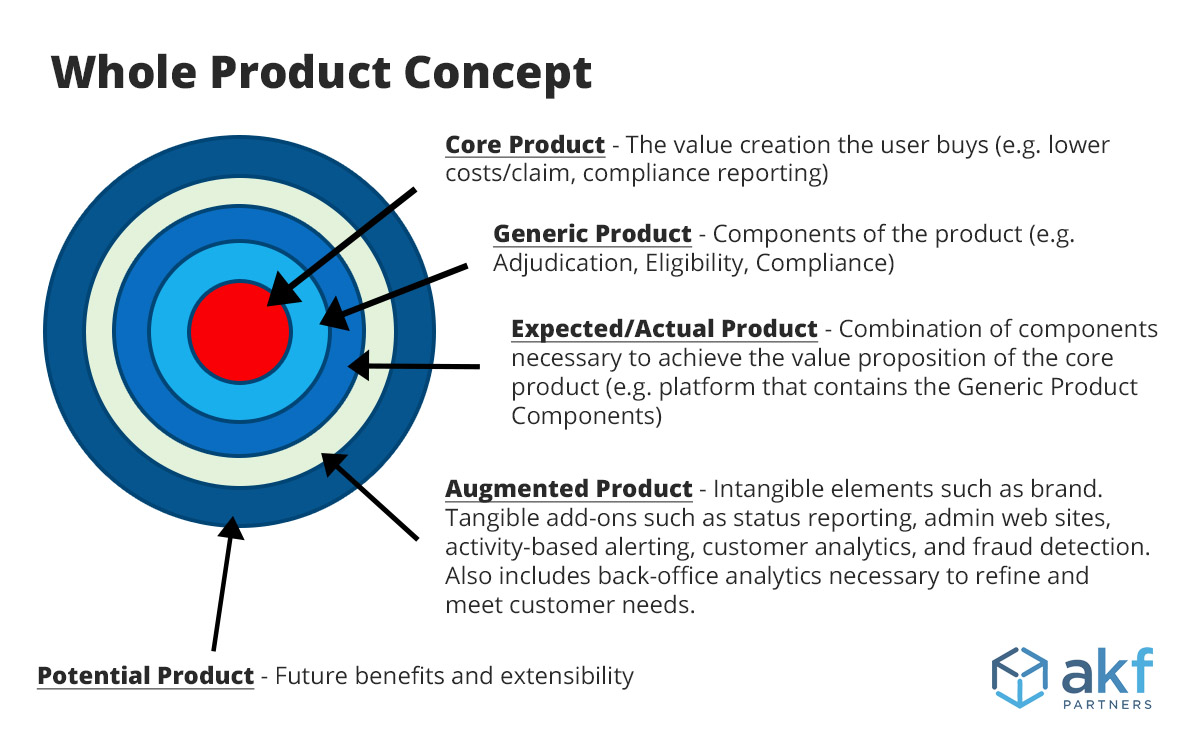What makes products successful? There are many aspects that contribute to the success of a product over time. We can trace back research to several prominent authors and influencers:
- Theodore Levitt's "The Marketing Imagination" in 1983. Theodore introduces the notion of the Total Product Concept. The Total Product captures intangible elements surrounding a physical product. These intangible elements include quality, packaging, customer service, delivery, and support.
- Regis McKenna's pioneering of the Diffusion of Innovation model. McKenna used the Diffusion of Innovation and Total Product Concept to explain how to move through the Technology Adoption Lifecycle (TALC).
- Geoffrey Moore's "Crossing the Chasm" in 1991. Moore popularized the TALC and introduced the Whole Product Concept.

Figure 1: Whole Product Concept
These concepts have stood the test of time for the most part: 40 years for the Total Product Concept and 30 years for the Whole Product Concept.
Unfortunately, there are a few aspects missing from the Whole Product Concept for Software as a Service (SaaS):
- Risk-shift of SaaS. Providers of SaaS take on the burden, risk, and cost of running solutions.
- Customer expectations. The desire for implementation at the speed of thought. Easy 'codeless' integrations for 3rd party solutions. Both are critical to creating an ecosystem of value.
- Time to market. Faster agile deployments need modularized platforms which can be easily iterated.
- Switching costs decrease. Faster customer onboarding makes it easier to switch providers.
SaaS companies must innovate faster. They must bring these innovations to market in a fraction of the time of on-premises solutions. They need to continually stay ahead of the competition.
To innovate faster in SaaS, the Whole Concept model needs some updates. Our colleague Brian Nejmeh, President of Instep, in collaboration with Geoffrey Moore has developed a new Whole Product concept focused on the needs of the SaaS market.
Gone is the notion of a 'generic' product. Generic products in software were commonly implemented as monoliths. The monolith is replaced by a platform of services surrounding a "core" product. The model is visualized with spokes surround the doughnut core. Each spoke addresses critical elements of successful SaaS. Some key aspects that we want to call out are:
- Buyer Journey - the journey changes from IT departments as the primary buyer to business leaders. This has an enormous impact on the sales organization. For example, when the customer switches from a free trial to a paid purchase, how does this change compensation?
- Modular Capabilities - how to bundle different aspects for different Personas and Jobs to Be Done. Unfortunately, many product managers do not know how to apply these concepts.
- Delivery Modes - to support various cloud and hybrid deployment models. Try to avoid multiple cloud infrastructures to lower COGS. This requires special sales skills to win early deals in legacy customers.
- Value Realization - measuring value of each feature with each release. Measuring real usage was almost impossible prior to SaaS. New platforms make this easy. They make it easy to tie into your CI-CD pipelines.
- Discovery & Enablement - start with a relentless focus on self-service. Focus on self-service for two high level Personas: business users and for technical managers. Measure who is adopting to refine the product for different verticals.
- Engagement - be best in class at customer support. This includes self-service communities. It includes proactive capabilities to prevent issues. It also includes reactive capabilities to recover quickly from issues. This typically requires a complex mix of platforms across the organization. Treat CRM for Sales and CRM for Support in the same way you treat your core product.

Figure 2: SaaS Whole Product Concept
The model serves as a new "North Star" for SaaS product managers. For existing SaaS players, it keeps key stakeholders focused on what made them successful. For companies transforming to SaaS, it helps identify the many changes necessary to win in the market.
But do not just take our word, take a read through the SaaS Whole Product Concept yourself.